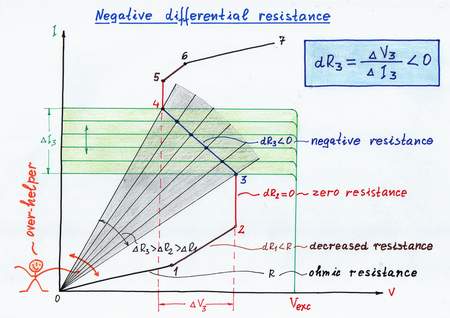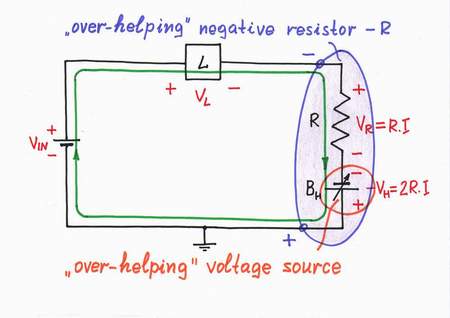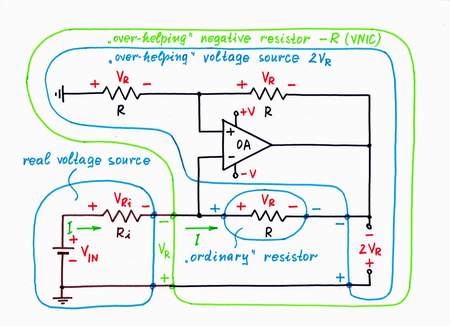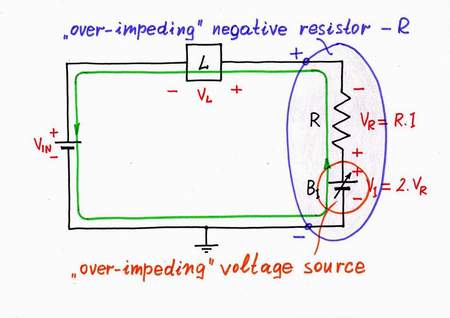![]() Third International Conference - Computer Science'06, Istanbul, Turkey, 12 - 15 October, 2006
Third International Conference - Computer Science'06, Istanbul, Turkey, 12 - 15 October, 2006
Cyril Svetoslavov Mechkov
Department of Computer Systems, Technical University of Sofia,
e-mail: cyril@circuit-fantasia.com, site: http://www.circuit-fantasia.com
|
||
2. REVEALING THE BASIC IDEA BEHIND NEGATIVE RESISTANCE |
||
2.1. Extracting the general idea from our routineWe may observe this phenomenon in situations where someone (something) interferes to some extent in our life. He/she/it may help or impede us in three degrees (under-, exactly- or over-). Negative resistance represents the last degree when someone "over-helps" or "over-impedes" us. Examples: parents over-help children doing their work as with a magic wand, the pneumatic amplifier over-helps the driver so much that he has only to try pressing the pedal and it moves itself etc. A negative resistance phenomenon is a process of injecting an additional excessive power to an existing power source; a negative resistor acts as an additional power source. |
||
2.2. A "positive" resistor versus negative resistorIn order to compare an ordinary "positive" resistor R with a negative resistor -R, let us assemble two circuits where these components are connected in series with the loads so that the same current passes through them. As a result, a voltage drop VR = R.I appears across the "positive" resistor R and the same voltage VH = VR = R.I appears across the negative resistor -R. |
||
|
The resistor R sucks the voltage V = R.I from the circuit (it is a voltage drop). So, an ordinary "positive" resistor acts as a current-to-voltage drop converter. The element named "resistor" is really a resistor. |
The negative resistor -R adds the voltage V = R.I into the circuit. So, a negative resistor acts as a current-to-voltage converter. It is actually a voltage source, whose voltage is proportional to the current passing through it. |
|
A negative resistor is just a voltage source, whose voltage is proportional to the current passing through it. |
||
3. HOW TO MAKE NEGATIVE RESISTORSOnce we have revealed the secret of negative resistance, we can already create a negative resistor. |
||
3.1. "Natural" negative differential resistors |
||
..based on constant-voltage dynamic resistors. We may obtain them, if we begin dynamically decreasing the ordinary ohmic resistor in four consecutive steps: [0-1] we have a "static" ohmic resistance R, [1-2] we decrease gradually the ohmic resistance R thus getting decreased differential resistance, [2-3] we decrease considerably enough the ohmic resistance, in order to get zero differential resistance, [3-4] we decrease enormously the ohmic resistance so the IV curve folds; as a result, we obtain the desired S-negative differential resistance. An S-shaped negative differential resistor is actually an "over-acting" voltage-stable dynamic resistor. |
 |
|
|
..based on constant-current dynamic resistors. Similarly, we may obtain the dual negative resistors, if we begin dynamically increasing the ordinary ohmic resistor in four consecutive steps: [0-1] we have a "static" ohmic resistance R, [1-2] we increase gradually the ohmic resistance R thus getting increased differential resistance, [2-3] we increase considerably enough the ohmic resistance, in order to get infinite differential resistance, [3-4] we increase enormously the ohmic resistance so the IV curve folds; as a result, we obtain the desired N-negative differential resistance. An N-shaped negative differential resistor is actually an "over-acting" current-stable dynamic resistor. |
 |
|
3.2. "Circuit" true negative resistorsIn op-amp circuitry, we prefer to make dynamic resistors by varying the voltage. Following this approach, we can make "circuit" true negative resistors by connecting in series a "positive" (ohmic) resistor and an "over-acting" voltage-controlled voltage source (an amplifier): "Positive" resistor + "over-acting" varying voltage source = true negative resistorWe may see this idea in many cases of our routine where, in order to begin creating something positive (-R), we first need something negative (R). Then, we produce two (or many) times more positive quantity (-2R) in order not only to compensate the negative quantity (R) but also to get the desired positive quantity (-R = -2R + R). A "circuit" true negative resistor -R contains internal resistor R and a doubling voltage amplifier (K = 2). |
||
...with "over-helping" voltage source. |
||
 |
 |
|
The idea. First, let us connect the additional voltage source so that it adds its voltage to the voltage of the input voltage source VIN (traversing the circuit clockwise the signs are - VIN +, - VH +). In this way, VH "over-helps" VIN since its voltage is two times more than the voltage drop VR. As a result, it reverses the voltage over the resistor R while the current continues flowing in the same direction. That is why, these kinds of "circuit" negative resistors are named NIC with voltage inversion (VNIC). |
The implementation. In order to put this idea in practice, we may connect in series to the resistor R the output part of an op-amp amplifier, which doubles the voltage drop across the resistor. Actually, the main task of the op-amp in this circuit is to remove the resistance R. In order to convert this circuit into VNIC, we have just to "mislead" the op-amp making it "over-act". If we connect a voltage divider (with K = 0.5) to the non-inverting input, we will make the op-amp "over-compensate" twice the voltage drop VR; thus we will get a negative resistance -R. |
|
An operation. The op-amp continuously compares 1/2 of its own output voltage VOA with the voltage drop VR across the resistor R by subtracting the two voltages. It "observes" the result of the comparison (the voltage difference between the two inputs) and keeps it almost zero by adjusting the output voltage VOA. The op-amp is "misled" - it has to generate two times higher voltage VOA = -2VR = -2R.I, in order to keep zero voltage between its two inputs. Half the voltage (-VR) compensates the voltage drop VR; the rest half (-VR) is added to the excitation voltage source VIN. The resistance of VNIC is RVNIC = (-V)/I = -R. |
||
...with "over-impeding" voltage source. |
||
 |
 |
|
The idea. If we reverse the additional voltage source, it will subtract its voltage from the voltage of the input voltage source VIN (traversing the circuit again clockwise the signs are - VIN +, + VI -); now, VI will "over-impede" VIN. As a result, it reverses the current passing through the resistor R while the voltage across the new "resistor" -R keeps the old polarity. That is why, these kinds of "circuit" negative resistors are named NIC with current inversion (INIC). |
The implementation. In this case, we have again to make the op-amp produce two times higher voltage than the voltage drop VR. Only, it has now to act as an "over-impeding" voltage source. Again, if we connect a voltage divider with K = 0.5 between the op-amp output and the inverting input, we will make the op-amp to "over-act". Actually, we have obtained the classical circuit of an op-amp non-inverting amplifier with K = 2. |
|
An operation. As above, the op-amp continuously compares 1/2 of its own output voltage VOA with the voltage drop VR across the resistor R by subtracting the two voltages. As usual, it "observes" the result of the comparison (the voltage difference between the two inputs) and keeps it almost zero by adjusting the output voltage VOA. Again, the op-amp is "misled" - it has to generate two times higher voltage VOA = 2VR = 2R.I, in order to keep zero voltage between its two inputs. Actually, it doubles the voltage VR appearing at the left side of the "ordinary" resistor R and applies it to its right side. Half the voltage (VR) compensates the voltage drop VR; the rest half (VR) is subtracted from the excitation voltage source VIN. As a result, the current I reverses its direction - now it flows into the input voltage source. The resistance of INIC is again RINIC = V/(-I) = -R. |
||
4. CONCLUSIONS
|
||